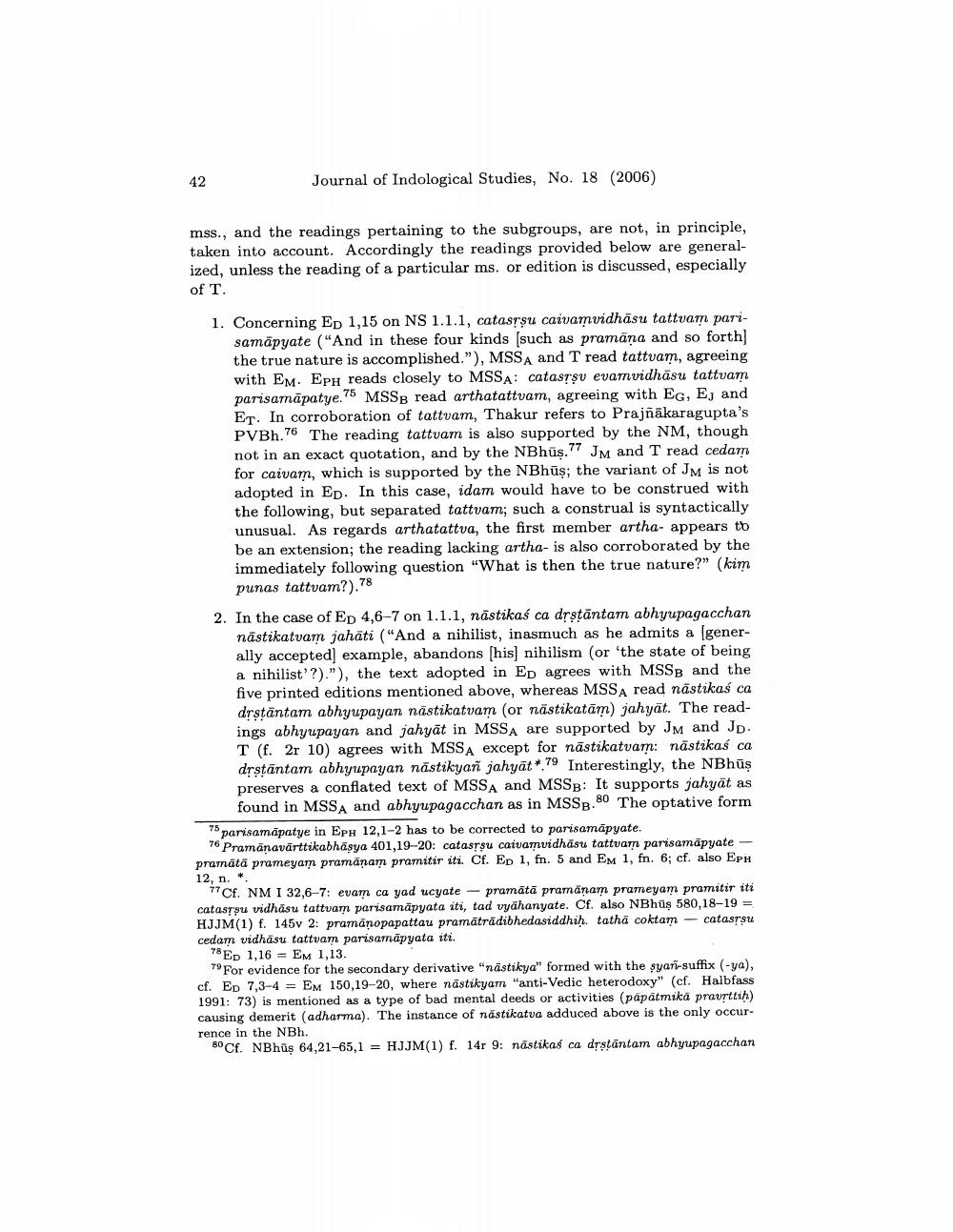________________
42
Journal of Indological Studies, No. 18 (2006)
mss., and the readings pertaining to the subgroups, are not, in principle, taken into account. Accordingly the readings provided below are generalized, unless the reading of a particular ms. or edition is discussed, especially of T.
1. Concerning Ep 1,15 on NS 1.1.1, catasrsu caivamvidhāsu tattvam pari
samāpyate ("And in these four kinds (such as pramana and so forth the true nature is accomplished."), MSSA and T read tattvam, agreeing with EM. Eph reads closely to MSSA: catastsv evamvidhāsu tattvam parisamāpatye.75 MSSB read arthatattvam, agreeing with EG, Ej and Et. In corroboration of tattvam, Thakur refers to Prajñākaragupta's PVBh.76 The reading tattvam is also supported by the NM, though not in an exact quotation, and by the NBhus. JM and Tread cedam for caivam, which is supported by the NBhūs; the variant of JM is not adopted in Ed. In this case, idam would have to be construed with the following, but separated tattvam; such a construal is syntactically unusual. As regards arthatattva, the first member artha- appears to be an extension; the reading lacking artha- is also corroborated by the immediately following question "What is then the true nature?" (kim punas tattuam?).78
2. In the case of Ep 4,6-7 on 1.1.1, năstikaś ca drstantam abhyupagacchan
nästikatvam jahäti ("And a nihilist, inasmuch as he admits a generally accepted) example, abandons (his nihilism (or 'the state of being a nihilist'?)."), the text adopted in Ep agrees with MSSB and the five printed editions mentioned above, whereas MSSA read nästikaś ca drstantam abhyupayan nästikatuam (or nästikatām) jahyāt. The readings abhyupayan and jahyāt in MSSA are supported by JM and JD. T (f. 2r 10) agrees with MSSA except for nāstikatvam: nāstikaś ca drstāntam abhyupayan nāstikyan jahyāt*.79 Interestingly, the NBhūş preserves a conflated text of MSSA and MSSB: It supports jahyāt as
found in MSSA and abhyupagacchan as in MSSB.80 The optative form 75 parisamāpatye in Eph 12,1-2 has to be corrected to parisamäpyate.
" Pramanavārttikabhäsya 401,19--20: catas?su caiuamvidhäsu tattuam parisamāpyate - pramātā prameyam pramanam pramitir iti. Cf. Ep 1, fn. 5 and Em 1, fn. 6; cf. also EPH 12, n. *
77 Cf. NM I 32,6-7: evam ca yad ucyate - pramātā pramanam prameyam pramitir iti catastşu vidhäsu tattvam parisamāpyata iti, tad vyāhanyate. Cf. also NBhuş 580,18-19 = HJJM(1) f. 145v 2: pramāṇopapattau pramātrādibhedasiddhiḥ. tathā coktam - catastsu cedam vidhäsu tattvam parisamāpyata iti. 78 Ep 1,16 = EM 1,13.
For evidence for the secondary derivative "nastikya" formed with the syan-suffix (-ya), cf. Ep 7,3-4 = EM 150,19-20, where năstikyam "anti-Vedic heterodoxy" (cf. Halbfass 1991: 73) is mentioned as a type of bad mental deeds or activities (papātmikā praurttih) causing demerit (adharma). The instance of năstikatva adduced above is the only occurrence in the NBh.
80Cf. NBhūş 64,21-65,1 = HJJM(1) f. 14r 9: nästikaś ca drstāntam abhyupagacchan




